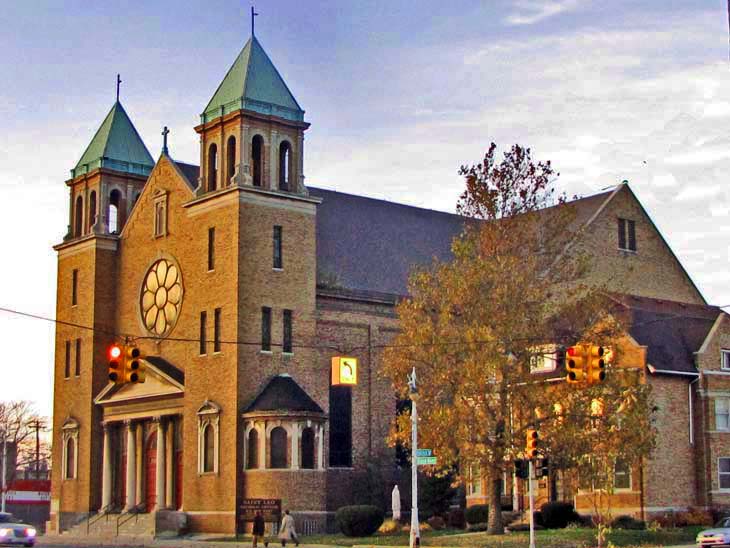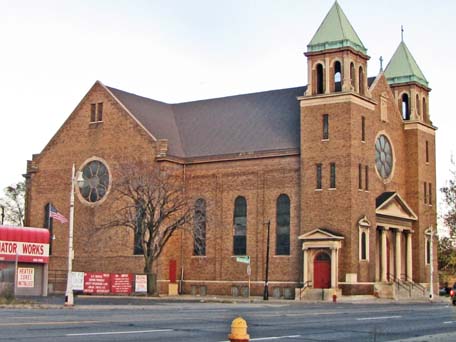

The Roman Catholic population of Detroit grew rapidly after 1880 as numerous immigrants arrived from Europe, while others migrated from around the United States and Canada to take jobs in the emerging manufacturing industries. By the late 1880s, there were about 200 Catholic families living along or near Grand River in this neighborhood of Detroit’s West Side. Bishop John Foley established a new parish in August, 1889. Father Matthew Meathe was appointed the first pastor. He must have been a very entrepreneurial leader. He had an elementary school in operation by 1890, and two years later, there was a secondary school. He built a temporary church that could welcome 500 congregants and shortly after, he opened a large high school that survived until 1971.
Father Meathe wished to construct a very impressive new church. He was upset with the idea of building a church that would contain many large pillars in the nave as churches typically did. In his view, pillars blocked the view of the altar and thereby made it more difficult for the faithful to appreciate the liturgy and homilies. One of the parish members was Detroit architect Harry J. Rill who accepted the challenge to design a large church without pillars. Rill and his wife toured Europe seeking inspiration for a massive church without pillars. He found exactly what he was seeking in L’Église Sainte-Marie-Madeleine in Paris.
 The first commission for the erection of a church on the site of L’Église Sainte-Marie-Madeleine in Paris was issued in 1757, just after Detroit reached 50 years in age. In 1764, the architect Pierre Contant d’Ivry began building a church. However, he died in 1777 with very little of the structure completed. He was replaced by the Parisian architect Guillaume-Martin Couture who intended to build a church that would resemble the Roman Pantheon. At this time the classical architecture of the Greeks and Romans was assumed to be a model of excellence for the western world.
The first commission for the erection of a church on the site of L’Église Sainte-Marie-Madeleine in Paris was issued in 1757, just after Detroit reached 50 years in age. In 1764, the architect Pierre Contant d’Ivry began building a church. However, he died in 1777 with very little of the structure completed. He was replaced by the Parisian architect Guillaume-Martin Couture who intended to build a church that would resemble the Roman Pantheon. At this time the classical architecture of the Greeks and Romans was assumed to be a model of excellence for the western world.
By the time of the French Revolution, only the foundation for the new church had been finished. The construction stopped in the violent Revolutionary Era that was, directly or indirectly, responsible for the migration of Father Gabriel Richard to the United States and then, later, to Detroit. In 1806, Napoleon changed plans and decided that the site should be dedicated to a commemoration of his troops. I believe that he called it: Temple de la Glorie de la Grande Armée. Napoleon commissioned architect Pierre-Alexandre Barthélémy Vignon to erect that temple. However, the Arc de Triumphe was built in 1808 reducing the need for another building commemorating Napoleon’s troops. I infer that construction stopped once again.
Napoleon did not live a long and peaceful life in Paris. After the restoration of the Monarchy, Louis XVIII was installed as sovereign in 1814. The king decided that the site should be returned to its original purpose as a church. This time, Jacques-Marie Huvé was selected as the architect. He decided that a Neo-classical building was most appropriate. But not all was settled. While Huvé was working on this church, there was discussion, in 1837, of converting the building into a railroad station. Those plans were tossed aside and L’Église Sainte-Marie-Madeleine was completed in 1842, just five decades or so before Harry Rill of Detroit visited. Rill must have been pleased to find a single nave with three domes at L’ Église Sainte-Marie-Madeleine.
The church Rill designed is basically in the Italian Renaissance style with Greek pillars on the outside—not inside—with their Corinthian capitals. There are two spires but, I believe, what we see today differ substantially from what the architect designed. The original spires included a series of three squared turrets composed of rounded arches.
The parish thrived for many years. Indeed, there was controversy in the 1920s when members of the parish who lived far from the church pressured Bishop Gallagher to establish a new congregation, pointing out that he had recently established St. Benedict the Moor parish for blacks and for Our Lady of Guadalupe parish for Mexicans. They contended that there were too few black or Mexicans to justify those parishes. Eventually, Bishop Gallagher relented and founded St. Dominic’s Parish using the former Brewster Congregational Church at the corner of West Warren and Trumbull.
This parish is named in honor of Pope Leo XIII who led the Roman church from 1878 to 1903. He is most famous for the Rerum Novarum encyclical that he issued on May 15, 1891. He recognized the development of urban working classes and very poor living conditions in cities. His encyclical discussed the rights and duties of both capital and labor. Importantly, he argued that the state should use its powers to promote social justice. In making these arguments, Pope Leo XIII was seen as strongly advocating for the world’s urban working classes and recommending that Catholics encourage governments to promote social welfare.
Detroit has a long history of well-known and prominent and/or controversial religious figures including the following:
Father Charles Coughlin who very strongly supported and then challenged President Franklin Roosevelt and the New Deal. He was also the priest who established the Shrine of the Little Flower at Twelve Mile and Woodward.
Reinhold Niebuhr who was pastor of Bethel Evangelical Church in Detroit from 1915 to 1928 and then went on to become a prominent and rather widely read theologian in the 1940s and 1950s.
Wallace P. Fard Muhammad, who is credited, by many, with founding the Black Muslim faith in Detroit and Highland Park in July, 1930.
Malcolm Little who came to Detroit to work in his brother’s furniture store after imprisonment in Boston and who, as Malcolm X, popularized the Black Muslim religion in the 1960. His last public presentation prior to his assignation in New York was in the Ford Auditorium.
The Reverend Albert Cleague who helped found a Pan African Orthodox Christian Church during the Civil Rights decade and pastured his Shrine of the Black Madonna here in Detroit.
The Reverend C. L. Franklin, pastor of New Bethel Church whose preaching style served as a model for young Baptist ministers who sought to reach urban African American congregations in the post World War II era but who may be equally well known because of the musical skills of his daughter, Aretha Franklin.
Perhaps some would add St. Leo’s Bishop Thomas Gumbleton to that list. He was born in Detroit in 1930, studied for the priesthood at Sacred Heart Seminary on West Chicago and was ordained in June, 1956. He held various pastoral and administrative appointments, moved up the ranks in the Detroit Catholic diocese and was anointed as an auxiliary bishop in 1968.
By the 1990s, Bishop Gumbleton became very active in the anti-war movement. For a long time there has been a Catholic pacifist movement, but it was never very prominent and few higher ranking clergy members joined that movement. Bishop Gumbleton did and was arrested for his protests against wars and against the Defense Department. Later, Bishop Gumbleton became what is known in Catholic circles as a dissident theologian. His writings and presentations were seen by conservative Catholics as inappropriately rasing question about the Catholic tradition of excluding women from the priesthood, as well as Catholic teachings about homosexuality. He also persistently questioned his church’s approach to the pedophilia issue. He claimed that he had been abused by higher ranking clergy when he was studying to become a priest in Detroit. It is not too unusual to find dissident theologians on the faculties of some Catholic colleges, but it was very unusual for a bishop to join their ranks. To be sure, Bishop Gumbleton became, at a minimum, a thorn in the side of conservative Catholics and their leaders in the hierarchy. At the same time, he was something of a hero to liberal Catholics and was honored with honorary doctorates from about a dozen “liberal” Catholic colleges.
In the early twenty-first century, Bishop Gumbleton attained age 75 when he was obliged to submit his resignation to the Roman bureaucracy and retire from the active ministry. He sought to continue as pastor of St. Leo’s and as an active spokesperson for the views of liberal Catholics. He fought his forced retirement but his appointment as pastor of St. Leo’s was terminated.
Bishop Gumbleton continued to speak out about pedophilia in the Roman Church and strongly criticized the church’s leaders who, he felt, did not take the issue of clergy abuse of children seriously enough. At one point, he testified before the Ohio legislature to encourage them to extend the statue of limitations so that victims of child abuse could sue those who, they believed, committed felonies. After that, the Papal Nuncio—the Pope’s representative in the United States—issued an edict requiring Bishop Gumbleton to obtain the approval of the local Roman Catholic bishop before he made any public presentations in their diocese. This effectively silenced Bishop Gumbleton, although his advancing age may also have played a role.
Most Catholic parishes in Detroit lost their membership in the years after 1950s and whites moved to the suburbs in great numbers, so many Catholic schools were closed and then, a few years later, the church was closed. A few parishes successfully found niche markets that kept them alive such as reaching out to an ethnic community. The Holy Cross parish in Delray, for example, ministers to Hungarians in southeast Michigan. Demographic changes reduced the Catholic population living near St. Leo’s but the parish decided to remain active by serving the needs of the poor. Today, this parish provides a variety of social services for Detroit's poor in keeping, in some sense, with the ideas Pope Leo XIII preached in Rerum Novarum.
Parish organized: 1889
Architect: Harry J. Rill
Date of completion: 1908
Architectural Style: Italian Renaissance with classical elements
Use in 2010: Active Roman Catholic parish
Website for Paroisse de la Madeleine: http://www.eglise-lamadeleine.com/
City of Detroit Designated Historic District: Not listed
State of Michigan Registry of Historic Sites: Not listed
National Register of Historic Places: Not listed
Photograph: Ren Farley; November 10, 2010
Description prepared: November, 2010